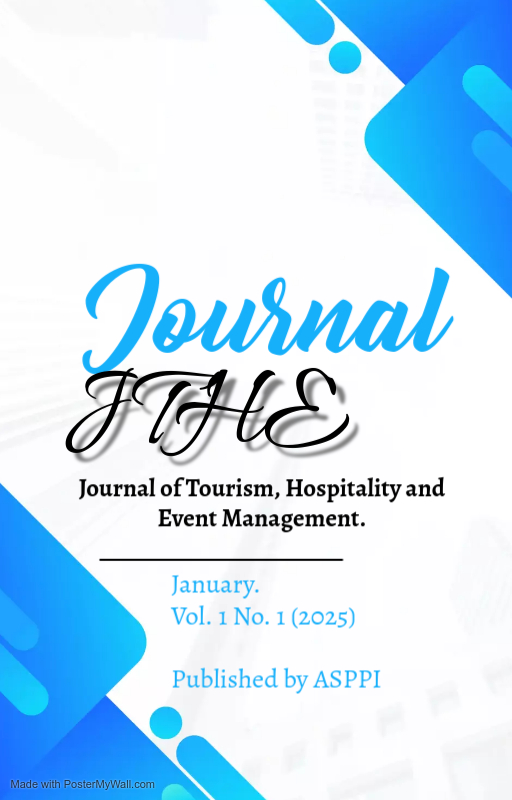UTILIZATION OF RED DRAGON FRUIT PEEL-BASED CREAM SOUP
Abstract
Dragon fruit skin has the potential to be used as a base for cream soup. This research aims to innovate red dragon fruit skin by carrying out the right process to produce delicious cream soup. The red dragon fruit skin is processed into puree or ingredients that have been softened to make it safe and mixed with spices to make it creamy. The method used includes processing dragon fruit skin into puree, then mixing it with spices and other additional ingredients. The results of the hedonic quality test show that the cream soup produced has a creamy texture and has a different taste from cream soups in general which usually use potato as the base ingredient. Based on research conducted, red dragon fruit peel as the main ingredient in making cream soup provides satisfactory results. Red dragon fruit skin is rich in fiber and antioxidants, so it not only uses food waste, but also increases the nutritional content of the product.
Downloads
References
Abdou, A. H., Hassan, T. H., & Dief, M. M. El. (2020). A description of green hotel practices and their role in achieving sustainable development. Sustainability (Switzerland), 12(22), 1–21. https://doi.org/10.3390/su12229624
Abdul Sahid, & Ambo Masse. (2023). Efektivitas Peranan Pemerintah Dalam Meningkatkan Jumlah Kunjungan Wisata Di Taman Nasional Bantimurung Kabupaten Maros. JOURNAL OF ADMINISTRATIVE AND SOCIAL SCIENCE, 5(1), 121–130. https://doi.org/10.55606/jass.v5i1.906
Apriliyanti, M. W., Suryanegara, M. A., Wahyono, A., & Djamila, S. (2020). Kondisi Optimum Perlakuan Awal Dan Pengeringan Kulit Buah Naga Kering. Jurnal Teknologi Dan Industri Pangan, 31(2), 155–163. https://doi.org/10.6066/jtip.2020.31.2.155
Carla Pramudita Susanto. (2022, June 22). Sering Konsumsi Sup? Simak 7 Manfaat Sup untuk Kesehatan. Hallo Sehat. https://hellosehat.com/nutrisi/fakta-gizi/manfaat-sup-untuk-kesehatan/
Ginting, I., Andry, M., Studi Farmasi, P., Farmasi dan Kesehatan, F., & Kesehatan Helvetia, I. (2023). Pemanfaatan Ekstrak Etanol Kulit Buah Naga Merah (Hylocereus polyrhizus) Dalam Sediaan Krim Lulur Sebagai Pelembab Alami Kulit Utilization of Red Dragon Fruit (Hylocereus polyrhizus) Skin Extract in Scrub Cream as a Natural Skin Moisturizer. Journal of Pharmaceutical and Sciences, 6, 1034–1049. https://www.researchgate.net/publication/372462599_Pemanfaatan_Ekstrak_Etanol_Kulit_Buah_Naga_Merah_Hylocereus_polyrhizus_Dalam_Sediaan_Krim_Lulur_Sebagai_Pelembab_Alami_Kulit
I Wayan Redi Aryanta. (2022). Manfaat Buah Naga Untuk Kesehatan. E-Jurnal Widya Kesehatan, 4(2), 8–11. https://doi.org/10.32795/widyakesehatan.v4i2.3386
Jati Palupi, P., Prasetia, R., Doddy Pratama, M., & Sriwahyuni, I. (2021). Karakteristik Fisikokimia Selai Kulit Buah Naga (Hylocereus polyrhizus). Jurnal Agroteknologi, 15(01). https://doi.org/https://doi.org/10.19184/j-agt.v15i01.20644
Mas Fian. (2024, July 30). Temukan Rahasia Kulit Buah Naga yang Jarang Diketahui, Wajib Tahu! Biotifor.
Muhammad Fatthul Rahman, R. A. P. S. M. (2022). Faktor Yang Berhubungan Dengan Frekuensi Konsumsi Makanan Jajanan Pada Siswa Sdn Mekasari 03 Tambun Selatan, Kabupaten Bekasi Tahun 2021. Jurnal Ilmiah Gizi Kesehatan, 21, 56–67. https://journal.thamrin.ac.id/index.php/jigk/article/download/1595/1348/6036
Neni Dewi Ratnaeni, & Dinna Rizky Amelia Putri. (2024). Samosa Kulit Buah Naga dan Saus Buah Naga Pada Perusahaan Kebun Naga Poernama Garut. Gemawisata: Jurnal Ilmiah Pariwisata, 21(1), 231–241. https://doi.org/10.56910/gemawisata.v21i1.459
Nilawati, N. K., Suriani, M., Pendidikan, R. P. J., & Keluarga, K. (2019). Pemanfaatan Kulit Buah Naga Menjadi Permen Jelly Kering. Jurnal Bosaparis: Pendidikan Kesejahteraan Keluarga, 10(2).
Nolandi, S. H., & Kusumastuti, A. (2019). Beauty And Beauty Health Education Journal Kelayakan Kulit Buah Naga Super Merah (Hylocereus Costaricensis) Sebagai Bahan Dasar Dalam Pembuatan Tinta Body Art. BBHE, 8(1). https://journal.unnes.ac.id/sju/index.php/bbhe
Nurul Faradila. (2024, April 27). Sering Dibuang, Inilah Manfaat Kesehatan Kulit Buah Naga yang Bersisik. Grid Health.
Oktawirani, P. (2023). Sinergi Inovasi dan Tradisi dalam Pengembangan Pariwisata di Desa Adat Kemiren. TOBA: Journal of Tourism, Hospitality and Destination, 2(1), 12–16. https://doi.org/10.55123/toba.v2i1.1852
Puspawati, I., & Riyani, N. (2021). Inovasi Produk Es Krim Dengan Pemanfaatan Limbah Kulit Buah Naga Merah dan Bunga Telang Sebagai Pewarna Alami. Seminar Nasional & Call For Paper Hubisintek, 370–374. https://www.ojs.udb.ac.id/index.php/HUBISINTEK/article/view/1410
Rusmiati, D. (2019). Untuk anak Health Education In Choosing Healthy Snack For Children .
Sardin, La Karimuna, & Abdu Rahman Baco. (2023). Pengaruh Penambahan Kulit Buah Naga Merah (Hylocereus Polyrhizus) Terhadap Kandungan Antioksidan, Nutrisi Dan Organoleptik Pada Jus Mentimun Sebagai Pangan Fungsional. J. Sains Dan Teknologi Pangan, 8(1), 5945–5958. https://ojs.uho.ac.id/index.php/jstp/article/download/34492/17685
Taroreh, W., Paat, C., & Tumiwa, J. (2019). Pemanfaatan Objek Wisata Pulau Kucing Dalam Meningkatkan Kesejahteraan Masyarakat Di Desa Fukweu Kecamatan Sanana Kabupaten Kepulauan Sula. HOLISTIK, 12(1). https://ejournal.unsrat.ac.id/index.php/holistik/article/view/24580/24279
Thasya, G., Gede, W. I., Mahendra Putra, A., Rosary, M., Arlin, M. P., & Sutisna, R. (2024). Characteristics of Ice Cream Innovation Based On Soy Whey and Dragon Fruit Peel Puree and Its Potential as a Functional Food. Journal Of Functional Food And Nutraceutical, 1–8. https://journal.sgu.ac.id/jffn
Wardaya, W., Hartanti, A. N., Wardani, D. S., Putri, Y., Nisa, S., Multatuli, M. R., Pembangunan, U., Veteran, N. ", & Timur, J. (2022). Inovasi Pengembangan Wisata Berbasis Masyarakat Studi Kasus Pada Kelurahan Sukolilo Baru Dan Kelurahan Kandangan Surabaya. Karya Jurnal Pengabdian Kepada Masyarakat, 2(1), 152–156. https://jurnalfkip.samawa-university.ac.id/karya_jpm/index
Section
License
Copyright (c) 2025 Liana Suseno, Alya Febiani, Febryola Indra, Vriandi Hapsara (Author)

This work is licensed under a Creative Commons Attribution-ShareAlike 4.0 International License.
Authors who publish with this journal agree to the following terms:
1) Authors retain copyright and grant the journal right of first publication with the work simultaneously licensed under a Creative Commons Attribution License (CC-BY-SA 4.0) that allows others to share the work with an acknowledgement of the work's authorship and initial publication in this journal.
2) Authors are able to enter into separate, additional contractual arrangements for the non-exclusive distribution of the journal's published version of the work (e.g., post it to an institutional repository or publish it in a book), with an acknowledgement of its initial publication in this journal.
3) Authors are permitted and encouraged to post their work online (e.g., in institutional repositories or on their website). The final published PDF should be used and bibliographic details that credit the publication in this journal should be included.





